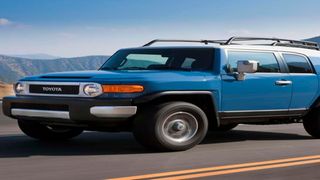
Toyota FJ Cruiser
| PoolDN2
Premium
Did you say you want to get yourself the Toyota FJ Cruiser?
Baraza, hope this finds you well. I am a fan of your column. Let me admit that I am a lover of the Toyota FJ Cruiser which meets my standards of a sturdy car to which I want to upgrade for off road and use in rough terrain. Please advise on cost, consumption, maintenance and availability of spare parts.

Toyota FJ Cruiser.
Muriithi.
Hi Muriithi,
Let me admit that I am not a lover of the Toyota FJ Cruiser because I find its looks questionable and unnecessary. It's one of the few cases of retro done wrong, but I'm sure there are people out there slowly sharpening bare bodkins as a preamble to their telling me to step closer and repeat what I said. I'd like to let these people know they have no taste.
That said: the FJ. It's a Prado in drag, so that should sum things up nicely. Cost is high because these people with no taste will pay large amounts of money for an eyesore (see BMW X6 for a citation), and therefore the dealers price them accordingly. You are looking at prices ranging from about Sh4million going up, while a Prado of the same vintage with the exact same mechanicals will cost a lot less while sparing our eyeballs the torture.
Consumption is fairly high because the FJ Cruiser is available with only one engine option: the 4.0-liter 1GR petrol V6, and only one transmission: a 5-speed automatic. This combination in a large metal shell with breezeblock aerodynamics does not exactly scream "economy", now, does it? Keyboard warriors will be quick to point out that a 6-speed manual is available. I know it is available, but I want these keyboard warriors to point out one such vehicle for me. I'll wait.
Maintenance is not for the regular Kenyan because this is a six-cylinder, 4.0-liter SUV, first and foremost. Yes, the legendary Toyota reliability is a consideration, but sundry costs such as servicing and parts replacement will be accompanied by a hefty invoice, there is no escaping this. I mean, we are talking about a vehicle with three wipers on one windscreen alone...
Availability of spare parts: well, like I said earlier, this is a Prado in drag. Spares should not be a problem.
Go for the FJ. Despite the gnarly looks, it is a sturdy vehicle and very capable off-roader, and you will attract the kind of attention you are seeking by buying a vehicle that looks like that.
Your two option are the Nissan X-Trail and Suzuki Escudo

Nissan Xtrail.
Hello
I want to buy a medium sized car 2000 cc, for instance a RAV4. To be honest, I lack the expertise to know which options I have but I know it needs to be two wheel with an option of 4WD. I need the option of 4WD for a small stretch of a rough muddy road I use frequently, but most of the time I’ll be driving on good roads.

Suzuki Vitara/ Escudo
Help
Barbs
Hi Barbs,
What you are requesting is a crossover with selectable 4WD, and once upon a time only two vehicle models offered that option: the Nissan X-Trail and the Suzuki Vitara a.k.a the Escudo. Of the two, the Escudo makes more sense as far as mudplugging and tackling the rough goes, but the X-Trail is better for tarmac work. The Escudo may also be a tad bit thirstier in comparison, but it will last longer.
How different is the Nissan Sylphy 2013 from the 2014 model?

Nissan Sylphy
Dear Baraza,
I trust that you are well.
I have a Nissan Sylphy 2013 model and recently read your take on the 2014 model. Are the two different or should I still be worried about overheating? I also realise that they are not very many on our roads. What could be the reason?
Thank you for the good work.
Daniel K.
Hi Daniel K,
The 2013 and the 2014 model years of Nissans Sylphy are the exact same car, the only difference being the date they left the factory. This Sylphy should be the B17 model.
I want to say you should be worried about overheating, but then again, you have an instrument cluster. Use it. Take remedial action at the first sign of trouble. Also do daily checks for other signs of trouble and despite the cost implications, you may want to take preemptive measures such as upgrading your cooling system through modifications such as installing an aftermarket radiator cap and so on.
There is a reason there are not so many Sylphys on the road and that is because at one point "They don't make 'em like they used to" was an adage that applied to a huge selection of Nissan cars, up to and including but not limited to the Sylphy. Issues with build quality and reliability plagued the lineup, made worse by lackluster visuals and a corporate oversight that preferred profit by cost-cutting. It wasn't pretty, and the brand's street credibility took such a dip.
I want a reliable, unique, non-problematic car whose spares are easily available and maintenance is not expensive…

Toyota Crown.
Hi JM Baraza,
Thanks for the good work you're doing. Please advise me - I am a first-time car buyer and I'm confused about the car to buy. Well, I want a reliable, unique, non-problematic, car, whose spare parts are easily available, and maintenance is not expensive.
Please advise me on the car to buy. My budget is below Sh1.5 million but can stretch to Sh1.6 or Sh1.7 - actually budget is not an issue, I'm just looking for a car with longevity and reliability. I also don't want these small cars - Demio, Vitz, etc. I also don't want a car that I'll buy, but always keep on checking whether the side mirrors have gone. I want a unique car that I won't have to be always worried about. Again, I want a car that is reliable (it doesn't have transmission or gearbox issues). I also want a car that has a good fuel economy, but one that won’t struggle on the road. Please advise me on whether 1500, 2000, or 2,500 cc will be strong and fuel-efficient.
Thank you.
Kind regards,
Mark
Hi Mark,
You want a reliable, unique, non-problematic car whose spares are easily available and maintenance is not expensive, right? Well, good for you. I also want a Ferrari, but at least I have chances, however slim, of indulging in my fantasies. You don't and here is why:
If you get a unique car, there is a very good reason why it is unique, and more often than not it's either because people cannot afford it, or because people do not want it. If people cannot afford it, then that is a whole other (brand new Range Rover) league where questions about maintenance costs are not tolerated. If people do not want it, then the biggest issues tend to be reliability issues and/or maintenance costs (second hand Range Rover). A car that is reliable and non-problematic with easily affordable and readily available spares will be a highly popular one, so you may want to go easy on the uniqueness criteria and get a Toyota.
And it will have to be a Toyota, for obvious reasons. The question is: how open-minded are you?
Think of the Toyota Crown. Go on, take a minute and think about it. It does tick the usual reliability boxes, no? And it is unique to some extent, not too many people have it. At 2500cc, it has both power on demand and economy on request. It's a biggish saloon, comfortable, somewhat stately, and if you shop around nicely, you can buy two of them for your Sh1.7 million. If your love for number plates exceeds your pennywise senses, you can get one recent import for that outlay.
Think about it....
Why are turbo charged cars faster than normal cars?

Finnish driver Kalle Rovanpera steers his Toyota Yaris WRC with Finnish co-driver Jonne Halttunen during the SS18 stage of the 2021 Safari Rally Kenya near Hell’s Gate at Lake Naivasha, Kenya, on June 27, 2021.
Hi Kimatia,
They're faster because they have higher outputs for the same mass. Let's take a 2.0-liter naturally aspirated car and pit it against the same model, but turbocharged. The turbo'ed vehicle weighs exactly the same as the naturally aspirated one - the extra weight of the turbo and affiliate plumbing is almost negligible relative to the mass of the vehicle, or even of the engine only, but the turbo means a higher air flow and increased fuel rate which in turn means higher performance without the weight penalty that comes with making engines bigger
How different is the Nissan Sylphy 2013 from the 2014 model?
Dear Baraza,
I trust that you are well.
I have a Nissan Sylphy 2013 model and recently read your take on the 2014 model. Are the two different or should I still be worried about overheating? I also realise that they are not very many on our roads. What could be the reason?
Thank you for the good work.
Daniel K.
Hi Daniel K,
The 2013 and the 2014 model years of Nissans Sylphy are the exact same car, the only difference being the date they left the factory. This Sylphy should be the B17 model.
I want to say you should be worried about overheating, but then again, you have an instrument cluster. Use it. Take remedial action at the first sign of trouble. Also do daily checks for other signs of trouble and despite the cost implications, you may want to take preemptive measures such as upgrading your cooling system through modifications such as installing an aftermarket radiator cap and so on.
There is a reason there are not so many Sylphys on the road and that is because at one point “They don’t make ‘em like they used to” was an adage that applied to a huge selection of Nissan cars, up to and including but not limited to the Sylphy. Issues with build quality and reliability plagued the lineup, made worse by lackluster visuals and a corporate oversight that preferred profit by cost-cutting. It wasn’t pretty, and the brand’s street credibility took such a dip.
My Subaru GG2 2005 won’t stop belching smoke

Subaru Sedan.
Hello JM,
Thank you so much for helping those of us who are not fortunate enough to know more about cars, your readership helps me catch up on the basics of so many issues regarding cars.
I am a proud owner of an old school Subaru GG2 year 2005 that I have owned for the last three years. Early this year, it started showing the annoying tendency to produce a lot of smoke when I turn it on in the morning or evening when leaving work. The smoke can last between 20 to one minute then it disappears completely. I have serviced it and replaced the oxygen sensor but the problem doesn't go away. Visits to Subaru Kenya Mombasa have not born any fruit - might you have a cure for this new disease? Will be delighted to hear from you.
With thanks and regards,
Masire Sam
Hi Sam,
Your problem seems fairly obvious: you have an oil leak into the engine, most likely through the valvetrain. This holds true for blue smoke. The leak occurs slowly when the engine is at rest, then on startup, the engine burns the oil that had seeped into the cylinders. Once all the oil has been burnt off, the smoke clears. Check your oil levels to see how fast they are dropping.
If you have white smoke, then you may have a different problem: these may be the early stages of head gasket failure. Subarus are notorious for this. To confirm if the gasket is going, there are a few checks you can do. First, check the coolant. Does it have an oily film floating on it? If yes, that is a sign.
Crank the engine and rev it, while still observing the coolant. Does it bubble in tandem with the engine revs? That too is a sign. Check your oil. Does it have traces of a whitish substance? That is yet another sign. Do a compression test and compare the numbers with the manufacturer's figures. Are yours significantly lower? That is another confirmation.





